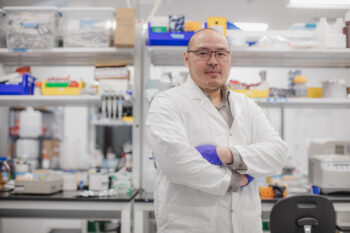Researchers at the University of Toronto and its partner hospitals have led the development of a heart-on-a-chip device to study the effects of a genetic mutation that causes dilated cardiomyopathy, a heart muscle disease that impairs blood flow throughout the body.
While it’s been difficult to study cardiac muscle cells due to incomplete tissue maturation in the lab, the U of T-led team was able to use the device to mature stem cells into adult cardiac tissue to observe the effects of a sodium channel mutation that disrupts regular electrical activity in the heart.
“Thanks to our heart-on-a-chip, we were able to overcome the challenges associated with the developmental regulation of the sodium channel mutation,” says Marianne Wauchop, first author of the study and former PhD student in the Department of Physiology at the Temerty Faculty of Medicine and the Department of Chemical Engineering & Applied Chemistry at the Faculty of Applied Science & Engineering.
“Using the same device, we were also able to determine the effects of the mutation on cardiac function.”
The journal Biomaterials recently published the findings.
The results could help advance personalized treatment for heart diseases such as dilated cardiomyopathy, a heart condition in which the chambers of the heart lose their ability to contract, through a mutation-targeted approach — even in cases where the mutation is not often linked to the disease or associated symptoms. If left untreated, the condition can result in arrhythmia — and eventually heart failure.
“Currently, patients with dilated cardiomyopathy caused by sodium channel mutations are treated for heart failure, such as with beta blockers and diuretics,” says Milica Radisic, a co-principal investigator on the study and professor at U of T’s Donnelly Centre for Cellular and Biomolecular Research and Institute of Biomedical Engineering. “Responses to these treatment methods are varied because they don’t target the specific mutations responsible for dilated cardiomyopathy.”
The researchers found the mutation disrupts interactions between sodium channels and structural proteins that are critical for cardiac muscle cells, leading to tissue dilation and impaired contractile performance.
The cells that carry the mutation were provided for the study by a patient of Kumaraswamy Nanthakumar, senior scientist in the Toronto General Hospital Research Institute at University Health Network and professor at U of T’s Institute of Medical Science in the Temerty Faculty of Medicine.
The patient went into cardiac arrest while giving birth and has a family history of arrythmia, an irregular heartbeat. Nanthakumar sequenced the patient’s genome to identify the particular sodium channel mutation.
“We were faced with the challenge of culturing stem cells that express the mutation in question, as this only occurs following maturation of the cells,” says Wauchop. “To address this issue, we developed a heart-on-a-chip device, also called a biowire, to mature the heart tissues cultured from stem cells.”
The research team created biowires with either tissues taken directly from Nanthakumar’s patient or tissues in which the mutation was corrected with CRISPR, a gene-editing tool.
While it typically takes a few years for patients to start experiencing symptoms of dilated cardiomyopathy after heart cells carrying the sodium channel mutation mature to their adult form, the biowires allowed the team to study the impacts of the mutation on cardiac tissue after only eight weeks.
Throughout this period, the researchers stimulated maturation of the stem cells through electrical current.
Dilated cardiomyopathy and other heart diseases can be caused by more than one type of mutation, Wauchop notes. But, she adds, “We can give patients a fighting chance by first making the connection between the mutation and the disease, and then developing targeted treatments for that specific mutation.”
This research was supported by the Canadian Institutes of Health Research (CIHR), the Peter Munk Cardiac Centre Innovation Committee and the National Institutes of Health (NIH).



